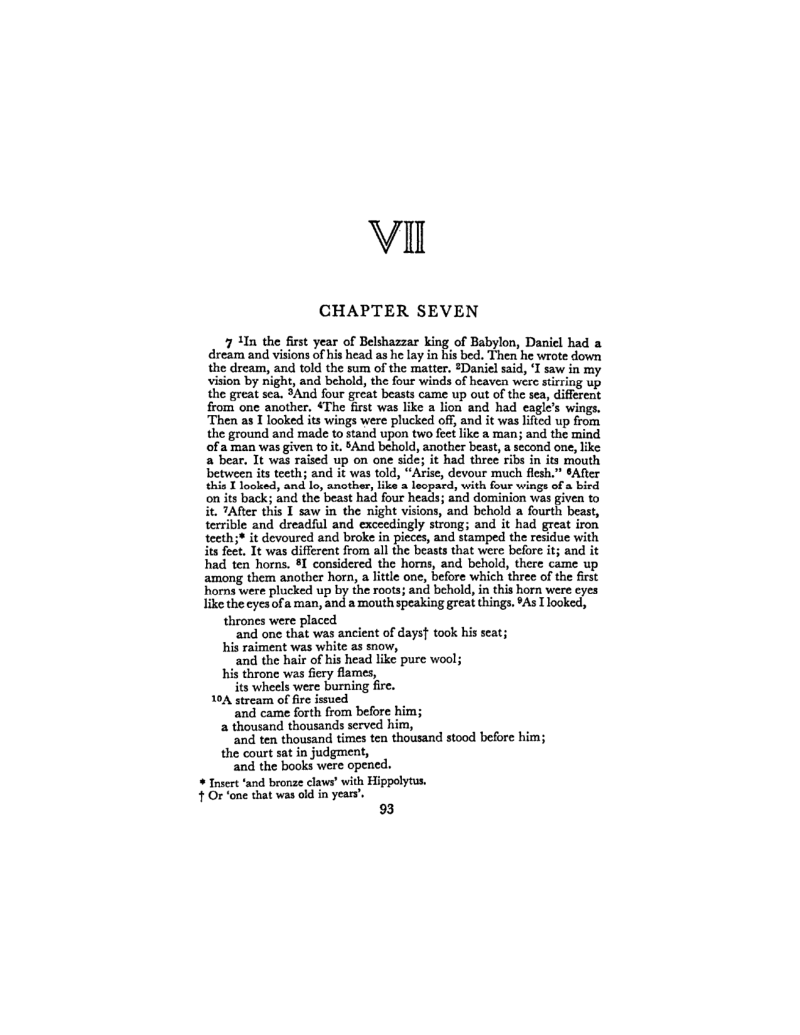Norman W. Porteous discusses Daniel 7 in relation to the "Ancient of Days."
- Type
- Book
- Source
- Norman W. Porteous Non-LDS
- Hearsay
- DirectSecondary
- Reference
Norman W. Porteous, Daniel (The Old Testament Library; Philadelphia: The Westminster Press, 1965), 96, 99
- Scribe/Publisher
- The Westminster Press
- People
- Norman W. Porteous
- Audience
- Reading Public
- Transcription
The first difficulty that has to be faced in interpreting this chapter is that of making up one's mind on the question of its unity. Part of the chapter is in plain prose, but the description of the tribunal (vv. 9- 10), the section about the one like a son of man (vv. 13-I4) and the interpretation of the whole vision (vv. 23-27) are rhythmical in style. That might point to disunity and lead to a theory of interpolation into an originally simple narrative. This radical solution, however, which suggests that the vision of the divine Judge holding tribunal and of the one like a son of man, who comes to the Ancient of Days and receives the dominion, had originally nothing to do with the vision of the four beasts, but has been artificially combined with it, does not commend itself. We can account for the abrupt changes of style by changes in the subject-matter or suppose that the author has drawn upon varied material in creating his total picture. Though a man of imagination and artistic sensibility, as is shown by the tremendous impact his book made on subsequent thought, he betrays, not only here but elsewhere in his book, a certain awkwardness in composition which may be regarded as a feature of his style as a writer. However clumsy certain of the transitions in chapter 7 are, then, to tear apart the chapter, as is proposed by some, would destroy the contrast which is surely intended between the symbolism of the beasts and the symbolism of the man-like figure, and would in the last resort leave 'the saints of the Most High' of the interpretation (v. 27) without a corresponding symbol in the vision.
It seems reasonable to regard vv. 2I-22 as the ill-conceived attempt of an interpolator to add something to the vision to correspond to something in the later interpretation, through his failure to recognize that a tendency to such elaboration in the interpretation of a prophecy or a vision is not without parallel elsewhere in this kind of writing. Indeed if vv. 21-22 are omitted nothing essential is lost. Further, vv. 13-14 require vv. 11-12 before them, describing, as they do, what was made possible after the carrying out of the sentence upon the beasts, and in particular upon the fourth beast, a sentence which was presumably pronounced by the Ancient of Days alone and carried out by his agents, though this is not explicitly stated. It is only after the age of the bestial empires has been brought to an end that authority is delegated to the one like a son of man.
. . .
When one looks again at chapter 7 and what the writer actually says, it must be recognized that whatever reference to the creation is intended is not made explicit. It is true that the expression 'the great sea' would probably suggest to a reflective reader that tehо̄m or abyss upon which order had to be imposed when God created the universe. The creatures which are represented in the vision as issuing successively from it, however, do not bear any notable resemblance to the monsters of the creation myth, either in appearance or function, but are intended rather to symbolize the brutal nature of the empires with which the Jewish people had had to do in the course of the last few centuries of their history. The nearest we get to the creation myth is in the description of the fourth beast (see below). Yet, even so, there is no reference to an actual conflict between the deity and the dragon. This, of course, may be due to the fact that, in the original Ugaritic mythology, the slaying of Leviathan was not credited to EI, between whom and the Ancient of Days of the vision in Dan. 7 there seems to have been some connection.1 In much the same way God ('elohim) in Gen. 1 does not take over the role of the slayer of the dragon but is elevated above the struggle, which is passed over in silence, though we know from various familiar allusions in the Old Testament that Yahweh could be represented as the actor in the mythological combat. What we find in Dan. 7 is the account of a judicial sentence, after which we learn that the fourth beast was killed-we are not explicitly informed by whom-and its carcase burned up.
- Citations in Mormonr Qnas
The B. H. Roberts Foundation is not owned by, operated by, or affiliated with the Church of Jesus Christ of Latter-day Saints.

